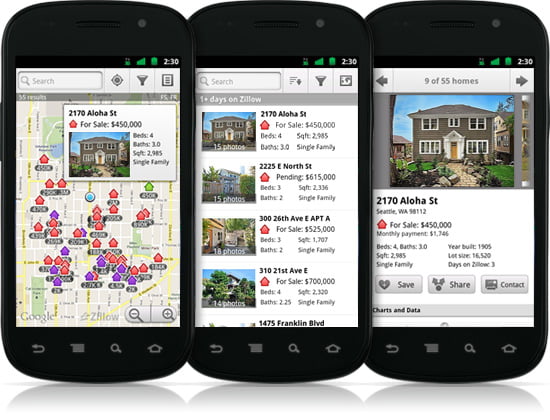App: Zillow Real Estate
Platform: iOS, Android, Kindle, Windows, Web
Cost: Free
Overview: Zillow’s mobile home search app provides a wealth of property information for potential buyers, but its usefulness for agents is limited.
How it works
Zillow’s home search app pulls the usual compliment of listing data: price, features, sales history, etc. But under the hood, Zillow is packed with features so comprehensive, they verge on overwhelming.
Unlike its competition, Zillow sets itself apart by offering data about:
- properties for sale by owner (FSBO);
- foreclosures and properties in pre-foreclosure;
- new construction;
- “make-me-move” properties (owners test the waters by posting a desired sale price, seeking responses); and
- rentals.
Zillow’s app uses mobile location data to pull up listing data in a color-coded map, or as a list. In either display, search results can be filtered by:
- property status;
- price range;
- property type (e.g., single or multifamily, etc.);
- the number of bedrooms (bathrooms are under “more filters”); and
- listing types (e.g., by agent, owner, builder or foreclosure).
The “show more filters” option enables users to filter for properties built in a certain year or listed for a certain length of time, or listings with scheduled open houses or recent price reductions.
Oddly, the main search box on the map screen is only equipped to search cities, ZIP codes and addresses. To find properties with specific features by key word, users have to navigate to the advanced filters menu.
One of the app’s more handy features is the draw-to-search function. Users are able to draw a search area on the map with their fingertip, and the app will only display results from within the drawn boundary. The value of this feature, of course, depends upon the user’s ability to identify their desired search area on a map or satellite image.
Select any property to view a bevy of information culled from multiple listing services, public records , third-party resources and Zillow’s proprietary algorithms. Photos, basic property information such as lot size, square footage, bed and bathrooms, the agent’s or seller’s description and a list of major features and metrics are shown first.
Following those, Zillow breaks down their Zestimate® of the property’s sale and rental value. The app charts changes in the Zestimate over time and compares it to their average estimate for the larger neighborhood or ZIP code, and provides histories of past listings, tax assessments and property tax bills.
Rounding out the property profile is a map of select amenities in the area, a breakdown of a typical monthly payment, estimates of homeowner expenses on utilities and services and ratings of nearby schools.
Finally, near the bottom, comes contact information for local agents. The listing agent, if any, appears first.
For brokers and their agents
On the web, Zillow is a force to be reckoned with. Buyers, sellers and agents alike have a powerful toolbox at their disposal — market research and analysis, networking and advertising capabilities, far-reaching listing aggregation, mortgage lending resources and more. Agents who spring for premium memberships have even greater control of their visibility and marketing power for their listings.
The mobile app, however, is clearly geared toward the casual user: those who may be thinking about buying or selling, or who are just curious about property values in their area.
To that end, the app’s value to brokers and agents is limited overall. The mobile version offers no special features specifically for real estate professionals, and listings cannot be added or edited from the app. While Zillow’s app is a great way to get basic property information on the fly, most of its data is pulled from public sources which may not reflect a property’s current condition or features.
The most useful feature for real estate professionals by far is the Zestimate and related pricing information, especially if used in an educational capacity. Zillow’s trademark price estimates are made visible at close zoom levels for all nearby properties whether they’re for sale or not. An agent might encourage a buyer or seller to get a sense of what a typical property in a given area goes for.
It also serves as a decent starting place for an agent to develop their initial thoughts on a property’s value. Of course, the variables that go into accurately pricing a property are far more complex than Zillow’s algorithms can account for.
Zillow’s far-greater web-based capabilities are where its real value to agents lies. In the end, the mobile app is just a small piece of a larger, more powerful operation.
first tuesday rating: 3.5 out of 5 stars, for offering only a fraction of Zillow’s full capabilities.














